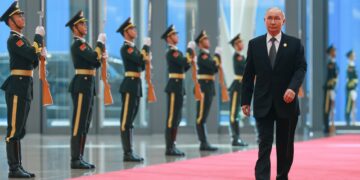August 15, 2025
Trump-Putin summit represents progress
FOR IMMEDIATE RELEASE:
August 15, 2025
Contact: press@defensepriorities.org
WASHINGTON, DC—Today, President Donald Trump and Russian President Vladimir Putin met in Alaska. Defense Priorities Director of Military Analysis Jennifer Kavanagh issued the following statement outlining four key takeaways from today’s historic summit:
1. The summit achieved progress and was a step toward peace. Though many speculated that the bilateral meeting would result in the end of the war in Ukraine, a sweeping deal of this sort was never likely. Mr. Trump himself defined the criteria for the meeting’s success differently: whether there was a second meeting. This now seems likely. The two leaders met face-to-face, strengthened their bilateral relationship, and suggested a readiness to continue the dialogue. Both men seemed positive about the gains their negotiations had achieved and optimistic about opportunities for future bilateral cooperation. No deals were announced, but this is not a bad thing nor is it an indication that the two sides did not find areas of agreement or reach new mutual understandings behind closed doors.
2. There is still a long road ahead to end the war. Mr. Putin and Mr. Trump described their discussions as honest and productive, and the two sides may have reached consensus on some of the issues that continue to block progress toward peace. But Mr. Putin made no concessions in his post-summit remarks, continuing to focus on Russia’s security concerns and alluding to the unaddressed root causes of the war. Fighting is likely to continue for some time, as Putin has no incentive to end the war while he has a military advantage, especially as Ukraine’s frontlines seem on the verge of collapse in some places. The summit may have revitalized diplomatic energy around ending the war, but a ceasefire seems a long way off.
3. President Trump did not throw Ukraine under the bus as some feared. Since returning to the White House, President Trump has received significant political blowback for his outreach and willingness to work with President Putin and his reluctance to punish Russia with new economic or military pressure. Naysayers in Europe and the United States have argued that Mr. Trump plans to give Ukraine to Putin or force Kyiv to accept surrender. Not once has he done so. After today’s summit, he made a point of reiterating that a final settlement is not his to make but Ukraine’s. His focus has been and remains getting Putin to the negotiating table. Mr. Trump deserves credit rather than condemnation for his efforts so far.
4. President Trump retains the ability to walk away and should be prepared to do so if today’s progress is fleeting or negotiations stall. Even after a successful summit, U.S. interests in the war in Ukraine remain limited. Mr. Trump’s primary concern should be avoiding any sort of long-term security guarantee that would tie the United States to Ukraine over the long-term and limiting future military resources committed to Ukraine now or in the future. Peace is one way to achieve this objective but it is not required. Mr. Trump can, at any time, decide that continued U.S. involvement diplomatically or militarily no longer serves U.S. interests and pull the plug. If today’s meeting with Mr. Putin does not kickstart serious negotiations—high-level and working-level—to end the war, Mr. Trump should not be afraid to walk. U.S. national security would not be harmed and could even be helped if the move conserves resources for domestic priorities.
More on Ukraine-Russia
Featuring Daniel Davis
September 15, 2025

Featuring Jennifer Kavanagh
September 11, 2025
Events on Ukraine-Russia







